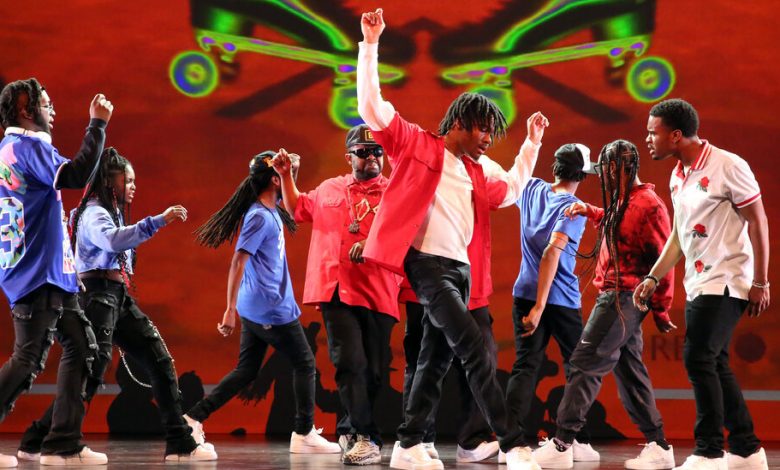Review: From Lil Buck, History and a Chance to Flash Some Brilliance

“This is going to be very educational for a lot of y’all,” Lil Buck said at Lincoln Center’s Rose Theater on Thursday.
He was speaking before the New York premiere of “Memphis Jookin’: The Show,” which he conceived, produced, helped choreograph and stars in.
Buck, also known as Charles Riley, is the biggest star of jookin, the Memphis-born street dance. He’s probably the only jookin specialist that most people have heard of. And because of how Buck became famous — dancing to classical music, collaborating with Yo-Yo Ma and ballet companies — many of those people might have misconceptions about the dance.
Hence this show, which seeks, in Buck’s words, to present jookin “in the world it comes from.” And to do so in the form of a 90-minute, touring theatrical production, with a plot and dialogue. Such street-to-stage transpositions can, and usually do, go wrong in a hundred ways. With more skill and care than originality, “Memphis Jookin’” mainly avoids the pitfalls. It’s sincere entertainment, packed with talent and heart. And, yes, it’s educational, too.
The story, serviceably if sometimes clunkily written by Ameenah Kaplan and Malcolm Barrett, follows JJ (the manic Dai’Vian Washington), a Memphis kid who decides to document the jookin scene with his dad’s camcorder. He goes to the Crystal Palace roller rink — an important location in jookin history and Buck’s biography — where his friend DJ Fly (Bradley Davis) is on the turntables. There we see a loosely staged scene of jookin in situ: little bursts of dancing that sometimes flare up into fights.
This narrative setup also allows DJ Fly to give JJ (and us) a history lesson about the development of the underground hip-hop music that goes with jookin (ably supplied by Marshall and Parker Mulherin and Young Jai). As he explains how changing technology allowed DJs to play with speed and rhythm, the lessons are illustrated with dancing that enjoyably demonstrates parallel development.
Throughout the show, the choreography (by Buck, Terran Noir Gary and Marico Flake) and the direction (by Amy Campion) work together to make points, flash some brilliance and keep things moving. A dance battle escalates into a generational confrontation when Buck arrives like a new-kid-in-town gunslinger to challenge the old-school champ Double OG (Flake, well known in urban dance circles as Dr. Rico).
It’s a smart use of the always affable Buck, acknowledging that his dancing is on another level. The otherworldly gliding in sneakers, the toe-tip balances that splay riskily and recover: He effortlessly pushes everything a little further. Double OG (a gruffly witty dancer who seems to be gracefully scraping schmutz from his shoes) admits defeat by resorting to violence. JJ and DJ Fly have to restore the peace.
This narrative turn is typical of the show’s dramaturgy, obvious but effective. JJ brings everyone together by showing them what he has recorded on his camera, scenes now danced by cast members as others pretend to watch the camcorder playback. What might have seemed like nothing much when we saw JJ filming the first Crystal Palace scene is now revealed, with some fast forwarding, to be quite wonderful: a trio of whiz kids, a boy-girl romance. We see Double OG teaching another cast member, Cameron Sykes, the basics of jookin, starting with the foundational gangsta walk, and Sykes manages the trick of pretending to be clumsy so he can transform into a marvel.
Then JJ’s camera and the documentary premise pay off again, this time with interviews. On the rear wall, we see video of one of the dancers (well edited by Joe Mulherin), telling his or her story, while onstage that dancer expresses the story through jookin. Elise Landrum sweetly explains how dance is therapy, how it’s kept her sane. Dra’em Hines talks about learning to dance from his father and how the other cast members supported him when his father died.
Buck tells some of his story, too, acting out his inspirations, including Crystal Palace dancers and Michael Jackson. The crux of his tale is a crisis, when a mentor told him that his dancing was “cool but not gangsta enough.” What he learned, he says, is that jookin wasn’t about skills and tricks; it was about expressing pain, love, joy, who you are.
His aspiration, he adds, is for people to recognize jookin as a “fine art.” The dancing — not just his, but everyone’s — makes its own case: inventive, expressive, impressive, hard-won. But the narrative points to goals other than respect or prestige. At the end, JJ uploads his footage to YouTube and watches in astonished triumph as his views and subscribers rocket into the millions.
During the post-show discussion, Flake was more frank about the show’s purpose — saying, in effect, that yes, jookin is art but artists need money. Landrum, in her interview segment, expressed delight in “getting paid to do what I like.” What these dancers need is a way to be professional without being Lil Buck. And this show that Lil Buck has made for and with them and taken on tour could be the answer.
Memphis Jookin’: The Show
Through Friday at the Rose Theater, Lincoln Center; lincolncenter.org.




